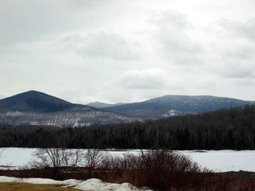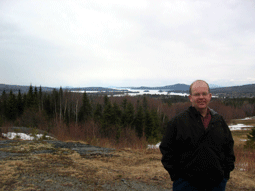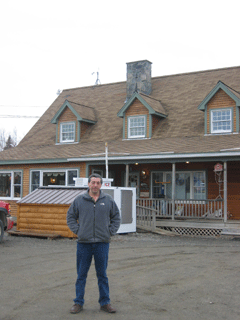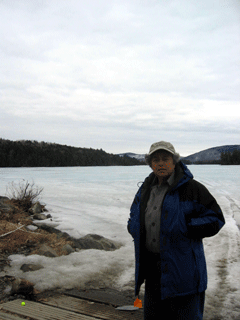Redefining a Region
Air Date: Week of March 31, 2006

(Photo: Ashley Ahearn)
There's change afoot in the nation’s forests. Timber companies have begun making more money on land sales than timber sales, and developers are quick to buy remote tracts for second home and vacation resorts. Living on Earth's Ashley Ahearn takes a look at what this national trend means for the Moosehead Lake region in Northern Maine.
Transcript
CURWOOD: From the Jennifer and Ted Stanley Studios in Somerville, Massachusetts, this is Living on Earth. I’m Steve Curwood.
More than half of the forestland in the United States is privately owned, almost a third of it by timber companies. Increasingly, companies that used to wait for their investments to grow on the stump are now looking for quicker returns, and in some cases that means real estate development. Living on Earth’s Ashley Ahearn visited the Moosehead Lake region in Maine, where some of the decline in the pulp and paper industry is set to be replaced by a large crop of vacation homes.
WOMAN: Alright, but now would you please join me and rise for our national anthem. And it's played by Ethan Pelletier.
[FIRST FEW NOTES]

Ethan Pelletier plays the "Star Spangled Banner" in the Greenville High school talent show. (Photo: Ashley Ahearn)
[LAST FEW NOTES OF THE STAR SPANGLED BANNER AND SOME APPLAUSE]
AHEARN: Twenty-one students will graduate from Greenville High this year. The incoming freshmen class numbers just 14.
SMITH: We’ve lost a lot of students.
AHEARN: Cory Smith became the principal of Greenville High five years ago.
SMITH: My first year here we were at 315 students. We’re down to 255 this year, and we'll probably be somewhere between 245 and 250 next year.
AHEARN: The drop in students isn’t because people are leaving. It’s because young people and families aren’t coming to Greenville. There just aren’t many jobs here anymore. The boom days for the paper and timber industries of Maine’s North Woods are over; operations out-sourced to South America or China, and forest jobs lost to mechanization.
Mainers have been living with the logging industry for more than a hundred years. Ninety-five percent of the state is privately owned, almost half of it by large timber companies. So when the Plum Creek Timber Company bought 900,000 acres in Maine in 1998, no one thought much would change.
But a year later something unexpected happened. Plum Creek Timber became the Plum Creek Real Estate Investment Trust.
DRAFFAN: Here's Plum Creek with 900,000 acres in Maine that it just bought, but it has no wood or paper manufacturing operations up there. It is basically a real estate company that's liquidating its properties.AHEARN: George Draffan has researched the timber industry extensively and co-authored the book “Strangely Like War: The Global Assault on the World's Forests.” In recent years, Draffan says Plum Creek has begun selling some of its holdings to developers who turn timberland into second homes and vacation resorts. Most notable, The Yellowstone Club, a 13,000 acre exclusive resort near the Big Sky ski area in Montana, and the Mountain Star Resort in Central Washington, which Draffan says covers six thousand acres and features.
DRAFFAN: Thousands of houses, hundreds of hotel rooms and condos, golf courses, a conference center, a spa, an ice rink – the thing goes on and on.
AHEARN: Timber companies can buy remote tracts of forest for as little as $200 an acre, and then sell plots, like those at Mountain Star, for as much as a million dollars an acre. According to the company's annual reports, Plum Creek's real estate income has tripled since 2003, and now totals $140 million. Other large timberland owners are showing similar increases in land sales.
DRAFFAN: It ends up being maybe ten percent of their revenues in any given year, but it's often up to 50 percent of their profit.

Luke Muzzy stands on Indian Hill, where his family has owned property for five generations, and looks out over Mooshead lake. (Photo: Ashley Ahearn)
MUZZY: I was excited about working for Plum Creek because I know I could use my knowledge of this area to make a plan that was gonna be good for Plum Creek and good for this area.
AHEARN: Muzzy's family has been in Greenville for five generations. Last April, he sold his successful real estate business to take a job as Senior Land Asset Manager for Plum Creek. He says the company has a unique opportunity to give the region what’s it never had before: a defined structure to future development.
MUZZY: To live here, and bringin' kids up here, and to have that unpredictability, you know, it was hard. How can you write a business plan and hire people and expand when everything around you is owned by somebody else, and you don't know what's going to happen with it?
AHEARN: Muzzy helped develop Plum Creek's initial plan for Moosehead, which was turned down by the Land Use Regulatory Commission. They said development needed to be more concentrated near existing towns, more land put into permanent conservation, and more affordable housing made available near the town of Greenville.
Plum Creek also proposed a 3,000 acre resort on Moosehead Lake, which many critics said was too big. The company is currently in talks with land conservation groups about permanent classification of roughly a third of its Maine lands as working forests. Muzzy says Plum Creek’s soon-to-be-released revised plan will put people at ease.
MUZZY: I’ll be able to look people in the eye and just say this is a great plan that has the potential to give this area predictability, and to keep the vitality of the town alive.
AHEARN: Area business owners like Fred Candeloro, who runs the Kokadjo Trading Post and Camps, grudgingly acknowledge the need for organized development and are putting a lot of faith in Plum Creek.

Fred Candeloro, owner of the Kokadjo Trading Post and Camps stands in front of his business. (Photo: Ashley Ahearn)
AHEARN: But no matter how scaled back Plum Creek's new plan may be, there are those who say development will fragment Mooshead's precious wilderness corridor.
BORETOS: I am still enthralled with the peace of not hearing man-made things here.
AHEARN: Diane Boretos is an ecologist and experienced wildlife tracker. She's standing at the edge of a pond where Plum Creek has proposed 30 housing lots.
BORETOS: We as humans are so myopic. We’re only one of hundreds of thousands of species, and this is where they live. And there’s a wholeness in wild places like this that speaks to our hearts and souls and that's why, for me anyways, I have to come to places like this to be reminded of that wholeness.
AHEARN: There’s no question that development on Moosehead Lake will disrupt wildlife, but a recent study by the Manomet Maine Center for Conservation Science says the footprint may be smaller than expected. John Hagan, who co-authored the study, says that although large landowners like Plum Creek might sell off parts of their land for development, they're more careful managers of biodiversity on the working forests they keep. Hagan says smaller investors are more pressed for quick returns on their land purchases.

Diane Boretos is an experienced tracker in the Moosehead region. (Photo: Ashley Ahearn)
AHEARN: Hagan says that as the map of the nation's forestland changes, there's a larger conversation to be had.
HAGAN: The public is only now starting to figure out that this land ownership change is happening. And I think once the public catches on they're gonna start to demand this conversation. We have to be thinking about, as a society, what do we want our forests to look like and what do we want them to be used for?
AHEARN: But for now, in the thawing woods of northern Maine at least, the focus is on the slushy expanse of Moosehead Lake. There’s a sense of waiting here. Waiting to see how Plum Creek's new development plan will change the region, and whether it will bring new jobs and new people here to put down roots where trees used to grow.
[MUSIC: Addie Pelletier performing “Forever Young” live by Alphaville from the ‘Greenfield, Maine Talent Show’ (March 2006)]
For Living on Earth, I'm Ashley Ahearn in Greenville, Maine.
Links
Living on Earth wants to hear from you!
Living on Earth
62 Calef Highway, Suite 212
Lee, NH 03861
Telephone: 617-287-4121
E-mail: comments@loe.org
Newsletter [Click here]
Donate to Living on Earth!
Living on Earth is an independent media program and relies entirely on contributions from listeners and institutions supporting public service. Please donate now to preserve an independent environmental voice.
NewsletterLiving on Earth offers a weekly delivery of the show's rundown to your mailbox. Sign up for our newsletter today!
 Sailors For The Sea: Be the change you want to sea.
Sailors For The Sea: Be the change you want to sea.
 The Grantham Foundation for the Protection of the Environment: Committed to protecting and improving the health of the global environment.
The Grantham Foundation for the Protection of the Environment: Committed to protecting and improving the health of the global environment.
 Contribute to Living on Earth and receive, as our gift to you, an archival print of one of Mark Seth Lender's extraordinary wildlife photographs. Follow the link to see Mark's current collection of photographs.
Contribute to Living on Earth and receive, as our gift to you, an archival print of one of Mark Seth Lender's extraordinary wildlife photographs. Follow the link to see Mark's current collection of photographs.
 Buy a signed copy of Mark Seth Lender's book Smeagull the Seagull & support Living on Earth
Buy a signed copy of Mark Seth Lender's book Smeagull the Seagull & support Living on Earth


